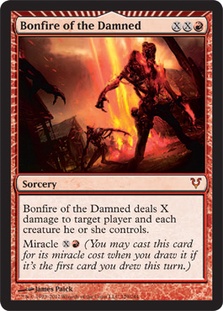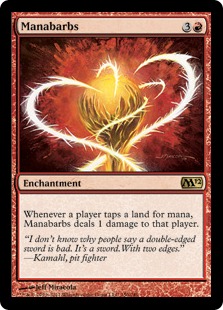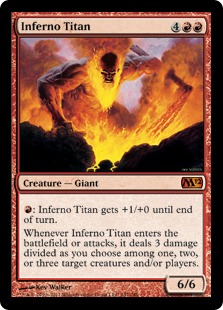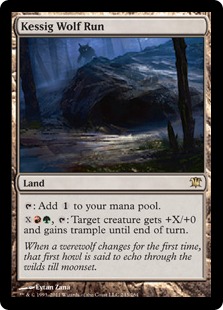Grand Prix Minneapolis was not at all what we predicted! As the first GP using Avacyn Restored, surprises were to be expected, but this Top 8 didn’t look anything like the familiar ones from before the new set. Nor did it look like the ones from the StarCityGames.com Open Series from the past two weeks. The results highlighted new cards, new archetypes, and new possibilities for the future of the format.
After going 6-3 on Saturday, I spent Day 2 exploring the top tables and learning what I could about the decks and players who were doing well. Based on my extensive knowledge of the format from before Avacyn Restored, I expected U/W Delver to crush the tournament and choke out many of the fringe strategies. Based on my limited knowledge of the new format, I expected revitalized beatdown decks like Zombies and Humans to perform well. I was surprised by what I saw.
Creatures (12)
Lands (23)
Spells (25)

I watched Christian Calcano’s U/R Delver deck in action throughout the day, and I was impressed. He seemed to have all of the most important strengths of classic Delver, but his efficient burn gave him extra stability in creature matchups and Delver mirrors. Beyond that, there was one card that seemed to put Mr. Calcano’s deck miles above the competition:
Bonfire is clearly a powerful card, but I for one didn’t realize just how powerful it could be. Wrath of Gods are good, after all, but Bonfire is no Wrath of God. For decks that would traditionally play Wrath, Bonfire of the Damned is expensive and unreliable. However, what makes it a unique and (I predict) format-defining card is its application in decks that would not traditionally play Wrath of God.
Between being a one-sided sweeper and having an attached Fireball effect, Bonfire of the Damned is a perfect card for aggressive strategies. Wiping the opponent’s board is dramatically more devastating when you have pressure of your own, and with complex, combat-oriented boards, the option to sandbag creatures doesn’t exist like it might against control decks.
But those are simply the general qualities of Bonfire of the Damned. Its value in Standard far outshines anything you’d be able to gauge just from reading the card. What’s remarkable is that X need not be a large number to drastically swing a game. I watched a whole day’s worth of Bonfire of the Damneds in Minneapolis, and it wasn’t the times that it was miracled or the times that its caster spent seven-plus mana that it most impressed me. It cleans up weenie creatures and tokens and offers a convenient answer to Invisible Stalker and Geist of Saint Traft. Marsh Casualties would be a brutal card in this format, and Bonfire is in a better color and—as Christian Calcano showed the world—is essentially splashable.
Watching Brandon Nelson’s G/R Aggro deck, Bonfire of the Damned seemed to add one extra angle of attack; one that opponents were powerless to prepare for. He would spend his early turns establishing a board presence, as would his opponent. He would carefully plan a race or a way to break a creature stall, as would his opponent. And then he would play Bonfire of the Damned, and suddenly things would look different… Between Brandon’s army, a small Fireball, an unchallenged attack, and shattered defenses, the opponent would be unable to claw his way back into the game.
And as impressive as Bonfire of the Damned was in G/R, it was even better in U/R Delver. Ponders and Gitaxian Probes provide more foreknowledge for planning out a big turn, and the blue deck’s simple ability to dig deeper gives a greater chance that the Bonfire will show itself at the perfect time.
Being an efficient answer to Geist of Saint Traft and Timely Reinforcements gives me hope that Bonfire of the Damned could potential revitalize the old Mono Red deck that was so successful in the early days of Innistrad Standard.
Creatures (20)
- 3 Grim Lavamancer
- 2 Spikeshot Elder
- 4 Chandra's Phoenix
- 4 Stormblood Berserker
- 4 Stromkirk Noble
- 3 Hellrider
Lands (23)
Spells (17)

Speaking from a traditional standpoint, Mono Red ought to be a good choice in a field where Blue Aggro is the most popular and successful strategy. Indeed, it was a great choice when Phantasmal Bears and Lords of the Unreal were the bread and butter of Delver decks. It’s simply a matter of a handful of standout cards seeing play in the current format that causes problems for Mono Red:
If you could somehow take those cards out of the equation, Mono Red would massacre Delver. Mono Red can easily remove Blue Aggro’s creatures, but not the other way around; Blue aggro takes significant damage from Phyrexian mana, and Mono Red can capitalize on it; Mono Red’s creatures are too fast to be vulnerable to Vapor Snag and Mana Leak.
Bonfire of the Damned now offers an appealing answer to both Geist of Saint Traft and Timely Reinforcements. What’s more, Christian Calcano’s victory in Minneapolis could herald a partial shift away from white as a support color for Delver.
Regarding Sword of War and Peace and Batterskull, the metagame is right for maindeck artifact removal. The top decks all lean heavily on artifacts: Delver and G/R (Swords), Wolf Run Ramp (Sphere of the Suns, Inkmoth Nexus, Solemn Simulacrum), Control (Ratchet Bomb and Pristine Talisman), and Birthing Pod, Grand Architect, and Tezzeret (obviously). Manic Vandal would be a fine option, but if you opt for Ancient Grudge, it’s only a short jump to include Faithless Looting as well.
Faithless Looting is one of the most powerful cards printed in recent memory. Careful Study leaves you down a card, so you’d typically only play it in extreme circumstances or in decks that take significant advantage from their graveyard. However, it’s my opinion that Faithless Looting is simply so good that it can be used in a completely fair capacity and should be a consideration for even non-graveyard red decks.
I believe that Faithless Looting can be a helpful addition for Mono Red. From the "fair" end of things, it smooths your draws and provides insurance against flooding (traditionally the easiest way to lose with Mono Red). It also allows you to ditch overpriced miracles if they’re in your opening hand. But my suggested decklist can also take advantage of a stocked graveyard. Looting provides fodder for Grim Lavamancer and allows you to fill your graveyard with Ancient Grudges, Geistflames, Devil’s Plays, and Chandra’s Phoenixes. Chandra’s Phoenix also happens to work very nicely with Bonfire of the Damned, returning from your graveyard as an effortless side effect.
I’m not sure exactly how this deck would compare to G/R Aggro and U/R Delver, but there’s something to be said for a pristine mana base and an abundance of burn. It’s also the only deck in the format that can make great use of the powerful Grim Lavamancer. Pillar of Flame offers a new weapon against Zombies, Strangleroot Geist, and Wurmcoil Engine.
One of the greatest appeals of red in general is its sideboard options. Threaten effects—Zealous Conscripts in particular—are remarkably powerful against ramp and scare people off (or should) of playing cards like Inferno Titan, Elesh Norn, Grand Cenobite, and Gisela, Blade of Goldnight, which would otherwise be hosers for red decks.
My own story of Grand Prix Minneapolis was a tragic one. For weeks I’ve been parading around boasting about how well my Grixis Control decklist matched up against G/R Aggro, a point which I would still defend…in a general sense… The problem was that I was woefully unprepared for a particular sideboard card:
Wouldn’t you know it, I found myself playing my bubble match in round 9 against G/R, and when he led with a Birds of Paradise and a Sword of War and Peace I knew it was time to put my money where my mouth was.
Things were going according to plan, with me enjoying a high life total and a clean board in the midgame. Unfortunately, though, he landed a Manabarbs, and I had to take six damage to cast my Grave Titan the following turn. Now, four mana for six damage is already good value, but what’s worse is that I could no longer use my flashback spells to dig for answers. On the final turn, I had to take two more damage to Ancient Grudge the Sword of Feast and Famine that was making his creature unblockable, and he Galvanic Blasted me to win the race on the dot.
As always, Manabarbs is an extremely powerful and unique card, and it makes me reconsider whether or not U/R/B is an acceptable color combination for a Standard control deck right now. Perhaps it was just that I cut down to two Mana Leaks out of fear of Cavern of Souls (a decision which proved to be a huge mistake), but I’d personally like to have the realistic options for beating a resolved Manabarbs that white offers.
With the declining popularity of control, Manabarbs might seem like an unrealistic sideboard card no matter how powerful it is. However, its backbreaking effect against control is, in reality, only the icing on the cake. Its primary use is against Wolf Run Ramp, which historically preys on aggressive creature decks.
Finally we come to the "big" red deck of the format, Wolf Run Ramp. People are playing tons of sideboard hate targeted at Wolf Run, namely Manabarbs and Zealous Conscripts, but I believe that a smart decklist and tight play can overcome it. It’s my opinion that Wolf Run Ramp is high in the running for the best deck choice at the moment.
Watching the top tables on Sunday, I saw Wolf Run players make good use of Glimmerpost and Natural End to put themselves out of range of Manabarbs. Primeval Titan and Wurmcoil Engine are the best options for win conditions, because even if they turn against you for a turn they’ll allow you to regain the life as long as you survive to untap.
I don’t recommend Bonfire of the Damned in Wolf Run, but only because it can utilize even better sweepers! Since Wolf Run is not likely to have an army of its own weenie creatures, it can take advantage of the cheap, efficient sweepers Whipflare and Slagstorm. Those are among the best cards in Standard right now, and time and again in Minneapolis I watched players reliant on mana dorks and hexproof creatures get massacred by the savvy Wolf Run pilots.
Bonus: Standard Sealed!
I was busy spectating on Day 2 of the GP, but I found time to enter an excellent side event anyway: Standard Sealed. In Standard Sealed, you’re given one booster pack of each set legal in Standard (Scar of Mirrodin Block, Innistrad Block, and M12) and build a 40-card deck any way you can.
Talking about the format before the event, we decided that people wouldn’t be able to capitalize on the built-in synergies like bloodthirst, morbid, metalcraft, and tribal themes like they might ordinarily be able to. Consequently, the format would be slow, grindy, and largely about late-game bombs.
While that assessment proved to be mostly right, I was fortunate to open a pool that could capitalize on that trend by deviating from it. I build a hyper-aggressive W/R deck with the goal of rushing people down before they could cast their Myr Battlespheres and Griselbrands.
My pool:
Razorverge Thicket
Skinwing
Tormentor’s Trident
Executioner’s Hood
Insatiable Souleater
Signal Pest
Phyrexian Digester
Golem Foundry
Golden Urn
Ichorclaw Myr
Strider Harness
Heavy Mattock
Victory’s Herald
Leonin Skyhunter
Fiend Hunter
Thalia, Guardian of Thraben
Silverblade Paladin
Gideon’s Lawkeeper
Loxodon Partisan
Gather the Townsfolk
Revoke Existence
Silverclaw Griffin
Smite the Monstrous
Spectral Gateguards
Siege Mastodon
Remember the Fallen
Loxodon Convert
Bar the Door
Abuna Acolyte
Tine Shrike
Lost Leonin
Spined Thopter
Crippling Chill
Thought Scour
Plated Seastrider
Neurok Commando
Selhoff Occultist
Amphin Cutthroat
Unsummon
Relentless Skaabs
Divination
Azure Mage
Master Thief
Sphinx of Uthuun
Amass the Components
Defensive Stance
Corrupted Resolve
Exsanguinate
Caustic Hound
Whispering Specter
Corpse Lunge
Walking Corpse
Abattoir Ghoul
Falkenrath Torturer
Searchlight Geist
Appetite for Brains
Warpath Ghoul
Gravedigger
Spread the Sickness
Grim Affliction
Entomber Exarch
Unhallowed Pact
Spiteful Shadows
Maw of the Mire
Ashmouth Hound
Oxidda Daredevil
Burn the Impure
Turn to Slag
Forge[/author]“]Chancellor of the [author name="Forge"]Forge[/author]
Volt Charge
Riot Ringleader
Manic Vandal
Hinterland Hermit
Curse of Stalked Prey
Kuldotha Ringleader
Lightning Prowess
Tormented Pariah
Tectonic Rift
Heirs of Stromkirk
Malicious Intent
Talons of Falkenrath
Concussive Bolt
Briarpack Alpha
Gravetiller Wurm
Pistus Strike
Woodland Sleuth
Pathbreaker Wurm
Spidery Grasp
Leeching Bite
Rampant Growth
Lifesmith
Bellowing Tanglewurm
Alpha Tyrranax
Bramblecrush
Death-Hood Cobra
Snare the Skies
Moonmist
Here’s the deck I built:

The great thing about this format is exploring card combinations that you would never see elsewhere. Curse of Stalked Prey is not a Constructed quality card, but sequences like turn 2 Leonin Skyhunter, turn 3 Silverblade Paladin, and turn 4 Curse of Stalked Prey make for priceless memories! Alternatively, how about playing Forge[/author]“]Chancellor of the [author name="Forge"]Forge[/author] to make four Goblin tokens with haste, attacking with your army, getting counters from the Curse, and following up with a Volt Charge the following turn!
I went 5-0 with the W/R deck, but I saw so many other awesome decks along the way that I’d be eager to try the format again with a different pool.
The StarCityGames.com Open Series offers Standard Sealed on Sundays, but I hope the format gets adopted by local tournament organizers too. It would be especially fun to cut to a Top 8 draft!
I spent my Sunday playing a format I’d never tried before and watching Standard players being rewarded for their hard work and innovation, which is something that always makes me happy. I didn’t get to play Day 2 of the Grand Prix, but it wasn’t all bad!





